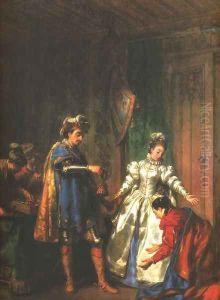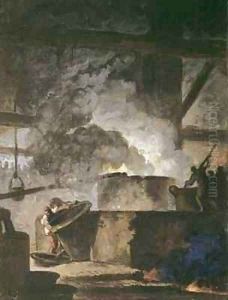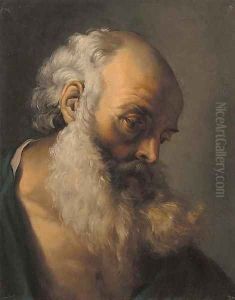Louis-Jacques Durameau Paintings
Louis-Jacques Durameau was a French painter born on September 14, 1733, in Paris. He was a prominent artist of the 18th century, known for his history paintings and his involvement with the decorative arts. Durameau first studied under the painter Jean-Baptiste Marie Pierre, the First Painter to the King, and later under the guidance of Noël Hallé. He was deeply influenced by the grand style of French classical painting, which is evident in his works that are characterized by their dynamic compositions, vibrant colors, and dramatic subject matter.
Durameau's talent was recognized early in his career when he won the prestigious Prix de Rome in 1759 for his painting 'The Death of Sophonisba.' The prize awarded him a scholarship to study at the French Academy in Rome, which was an important institution for the artistic training of French painters. During his stay in Italy, from 1760 to 1764, Durameau was influenced by the works of the Italian masters and the ancient Roman art and architecture.
Upon his return to France, Durameau continued to work on various important projects. He became involved in the decoration of royal palaces and public buildings, such as the Palais-Royal and the Hôtel de Ville in Paris. One of his significant contributions was the ceiling painting in the Apollo Gallery at the Louvre, which depicted 'Apollo Slaying the Python.' His work was well-received and illustrated the grandeur and elegance of the French neoclassical style.
Durameau was admitted to the Royal Academy of Painting and Sculpture in 1772 and received the title of professor in 1786. His association with the Academy allowed him to influence the next generation of French artists. Despite his success, the French Revolution brought significant changes to the artistic community and institutions in France. Durameau's royal and aristocratic patrons were displaced, and the shift in political power affected his career.
Louis-Jacques Durameau died on October 6, 1796, in Paris. While he may not be as widely remembered as some of his contemporaries, his contributions to French painting and his role in the decorative arts of the period remain significant. His works are preserved in various museums and collections in France, serving as a testament to the artistic heritage of the 18th century.



